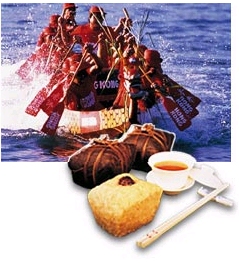Language
Marriage
Family
Sexuality
Gender
Religion
Arts
Bibliography

Respecting the minister as an upright and honest man, the people who lived in the area jumped into their boats and rushed out in a vain search for him. This unsuccessful rescue attempt is a part of what the Dragon Boat Festival commemorates every year.
Probably the most exciting and interesting aspect of the festival is the racing of the Dragon Boats. These races not only symbolize the people's attempt to save Chu Yuan, they also demonstrate the Chinese virtues of cooperation and teamwork.
The Dragon Boats feature the head and tail of a dragon, a mythological creature regarded by the Chinese as having dominion over the waters and exercising control over rainfall. The heads and tails are kept ashore during the year and are only affixed for the races. After they have been attached, it is necessary to bring the boats to life. This is done in a ceremony presided over by a Taoist priest and, amid the burning incense and exploding firecrackers, the eyes of the dragon heads are dotted with paint. Sacrificial paper money is put into the dragons' mouths and also thrown into the water by the rowers. All of this is done to dispel any evil spirits that might be lurking about waiting for an opportunity to disrupt the festivities.
Another activity of the Festival is the making and eating of a kind of dumpling called Tzungtzu. When it became known that Chu Yuan was gone forever, the people, living along the river, threw cooked rice into the water as a sacrifice to their dead hero. The local fishermen were later told in a dream that the fish, not Chu Yuan, got the rice. Therefore, the next time that they threw rice into the river, they first stuffed it into bamboo sections. This started the custom that has evolved into its present-day version: rice wrapped in bamboo leaves, stuffed with ham, beans, bean paste, salted egg yokes, sausages, nuts, and/or vegetables. ( In the picture is Kristin Jia-Ning Seid sampling a Tzungtzu at the House of China Dragon Boat Celebration, 1996. )
To the Chinese the fifth lunar moon is more than just the Dragon Boat Festival. Since antiquity, they have believed that this month is a pestilential and danger-fraught period. Children born in this month are said to be difficult to raise, and people tend to concentrate their efforts during this time attempting to protect their families from ills and misfortune. The day of the Dragon Boat Festival is customarily the time when cleaning and sanitation are stressed. Most families hang calamus and artemisia above their doors, both as a decoration and as a preventive against pestilence. There is an old saying to the effect that "a disease of seven years can be cured by three years of artemisia".
Ancient folk medicines such as realgar are added to the food eaten on the Festival day. This is believed to prevent disease and to promote a healthy digestive system. The drinking of realgar in wine supposedly relieves the effects of poisons accumulated in human bodies. Other customary foods of the season, all of which are alleged to have medical value, include garlic, pickled vegetables, greens and yellow croaker (a type of fish) Other protective measures taken on the day of the Dragon Boat Fesitval include, the painting of the ideograph Wang (King) on the foreheads of children with realgar or cinnabar, and the fastening of amulets containing spices or medicines to the buttons of their clothing.
These sachets (Hsiang Pao in Chinese) are very popular with children and they vie with each other to collect as many as possible. Children are not the only ones who collect Hsiang Pao. Older people are often given them as a symbol of respect, and they are highly prized because of the intricate and beautiful embroidery that adorns them. The Dragon Boat Festival is an entertaining and enjoyable event. It gives the observer an opportunity to glimpse a part of the rich Chinese cultural heritage.